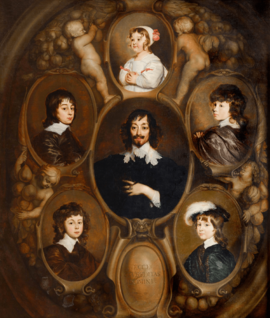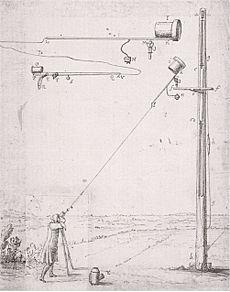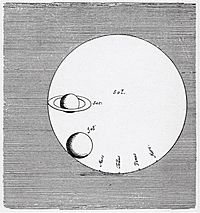Christiaan Huygens facts for kids
Quick facts for kids
Christiaan Huygens
|
|
|---|---|
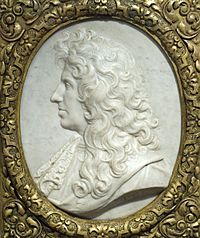
Christiaan Huygens, 1629-1695, relief by Jean-Jacques Clérion around 1670
|
|
| Born | 14 April 1629 |
| Died | 8 July 1695 (aged 66) |
| Nationality | Dutch |
| Alma mater | University of Leiden University of Angers |
| Known for | Titan Explanation of Saturn's rings Centrifugal force Collision formulae Pendulum clock Huygens–Fresnel principle Wave theory Huygens' engine Birefringence Evolute Huygenian eyepiece 31 equal temperament musical tuning Huygens–Steiner theorem |
| Scientific career | |
| Fields | Physics Mathematics Astronomy Horology |
| Institutions | Royal Society of London French Academy of Sciences |
| Influences | Galileo Galilei René Descartes Frans van Schooten |
| Influenced | Gottfried Wilhelm Leibniz Isaac Newton |
Christiaan Huygens, FRS (Latin: Hugenius) (14 April 1629 – 8 July 1695) was a prominent Dutch mathematician and scientist. He is known particularly as an astronomer, physicist, probabilist and horologist.
Huygens was a leading scientist of his time. His work included early telescopic studies of the rings of Saturn and the discovery of its moon Titan, the invention of the pendulum clock and other investigations in timekeeping. He published major studies of mechanics and optics (having been one of the most influential proponents of the wave theory of light), and pioneered work on games of chance.
Contents
Biography
Christiaan Huygens was born on 14 April 1629 in The Hague, into a rich and influential Dutch family, the second son of Constantijn Huygens. Christiaan was named after his paternal grandfather. His mother, Suzanna van Baerle, died shortly after giving birth to Huygens's sister. The couple had five children: Constantijn (1628), Christiaan (1629), Lodewijk (1631), Philips (1632) and Suzanna (1637).
Constantijn Huygens was a diplomat and advisor to the House of Orange, in addition to being a poet and a musician. He corresponded widely with intellectuals across Europe; his friends included Galileo Galilei, Marin Mersenne, and René Descartes. Christiaan was educated at home until the age of sixteen, and from a young age liked to play with miniatures of mills and other machines. From his father he received a liberal education, studying languages, music, history, geography, mathematics, logic, and rhetoric, alongside dancing, fencing and horse riding.
In 1644, Huygens had as his mathematical tutor Jan Jansz Stampioen, who assigned the 15-year-old a demanding reading list on contemporary science. Descartes was later impressed by his skills in geometry, as was Mersenne, who christened him the "new Archimedes."
At sixteen years of age, Constantijn sent Huygens to study law and mathematics at Leiden University, where he studied from May 1645 to March 1647. Frans van Schooten was an academic at Leiden from 1646, and became a private tutor to Huygens and his elder brother, Constantijn Jr., replacing Stampioen on the advice of Descartes. Van Schooten brought Huygens's mathematical education up to date, introducing him to the work of Viète, Descartes, and Fermat.
After two years, starting in March 1647, Huygens continued his studies at the newly founded Orange College, in Breda, where his father was a curator. Constantijn Huygens was closely involved in the new College, which lasted only to 1669; the rector was André Rivet. Christiaan Huygens lived at the home of the jurist Johann Henryk Dauber while attending college, and had mathematics classes with the English lecturer John Pell. His time in Breda ended around the time when his brother Lodewijk, who was enrolled at the school, duelled with another student. Huygens left Breda after completing his studies in August 1649 and had a stint as a diplomat on a mission with Henry, Duke of Nassau. It took him to Bentheim, then Flensburg. He took off for Denmark, visited Copenhagen and Helsingør, and hoped to cross the Øresund to visit Descartes in Stockholm. It was not to be.
Although his father Constantijn had wished his son Christiaan to be a diplomat, circumstances kept him from becoming so. The First Stadtholderless Period that began in 1650 meant that the House of Orange was no longer in power, removing Constantijn's influence. Further, he realized that his son had no interest in such a career.
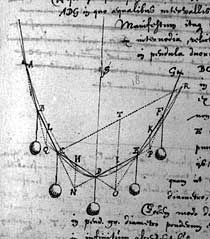
In 1646, while still a college student at Leiden, he began a correspondence with his father's friend, Marin Mersenne, who died soon afterwards in 1648. Mersenne wrote to Constantijn on his son's talent for mathematics, and flatteringly compared him to Archimedes on 3 January 1647.
The letters show Huygens's early interest in mathematics. In 1654, Huygens returned to his father's house in The Hague, and was able to devote himself entirely to research. The family had another house, not far away at Hofwijck, and he spent time there during the summer.
Between 1651 and 1657, Huygens published a number of works that showed his talent for mathematics and his mastery of classical and analytical geometry, increasing his reach and reputation among mathematicians. Around the same time, Huygens began to question Descartes's laws of collision, which were largely wrong, deriving the correct laws algebraically and later by way of geometry.
In addition to his work on mechanics, Huygens made important scientific discoveries: he was the first to identify Titan as one of Saturn's moons in 1655, invented the pendulum clock in 1657, and explained Saturn's strange appearance as due to a ring in 1659; all these discoveries brought him fame across Europe.
In 1666, Huygens moved to Paris on an invitation to fill a leadership position at King Louis XIV's new French Académie des sciences.
Huygens made further astronomical observations at the Académie using the observatory recently completed in 1672.
Huygens moved back to The Hague in 1681. His father died in 1687, and he inherited Hofwijck, which he made his home the following year.
On his third visit to England, Huygens met Isaac Newton in person on 12 June 1689. They spoke about Iceland spar, and subsequently corresponded about resisted motion.
Huygens returned to mathematical topics in his last years and observed the acoustical phenomenon now known as flanging in 1693. Two years later, on 8 July 1695, Huygens died in The Hague and was buried, like his father before him, in an unmarked grave at the Grote Kerk.
Huygens never married.
Astronomy
Saturn's rings and Titan
In 1655, Huygens proposed that Saturn was surrounded by a solid ring, "a thin, flat ring, nowhere touching, and inclined to the ecliptic." Using a 50 power refracting telescope that he designed himself, Huygens also discovered the first of Saturn's moons, Titan. In the same year he observed and sketched the Orion Nebula. His drawing, the first such known of the Orion nebula, was published in Systema Saturnium in 1659. Using his modern telescope he succeeded in subdividing the nebula into different stars. The brighter interior now bears the name of the Huygenian region in his honour. He also discovered several interstellar nebulae and some double stars.
Mars and Syrtis Major
In 1659, Huygens was the first to observe a surface feature on another planet, Syrtis Major, a volcanic plain on Mars. He used repeated observations of the movement of this feature over the course of a number of days to estimate the length of day on Mars, which he did quite accurately to 24 1/2 hours. This figure is only a few minutes off of the actual length of the Martian day of 24 hours, 37 minutes.
Cosmotheoros
Shortly before his death in 1695, Huygens completed his most speculative work entitled Cosmotheoros. At his direction, it was to be published only posthumously by his brother, which Constantijn Jr. did in 1698. In this work, Huygens speculated on the existence of extraterrestrial life, which he imagined similar to that on Earth.
Huygens wrote that availability of water in liquid form was essential for life and that the properties of water must vary from planet to planet to suit the temperature range. He took his observations of dark and bright spots on the surfaces of Mars and Jupiter to be evidence of water and ice on those planets. He argued that extraterrestrial life is neither confirmed nor denied by the Bible, and questioned why God would create the other planets if they were not to serve a greater purpose than that of being admired from Earth. Huygens postulated that the great distance between the planets signified that God had not intended for beings on one to know about the beings on the others, and had not foreseen how much humans would advance in scientific knowledge.
Legacy
Huygens has been called the first theoretical physicist and a founder of modern mathematical physics. Although his influence was considerable during his lifetime, it began to fade shortly after his death. His skills as a geometer and mechanical ingenuity elicited the admiration of many of his contemporaries, including Newton, Leibniz, l'Hôpital, and the Bernoullis. For his work in physics, Huygens has been deemed one of the greatest scientists in the Scientific Revolution, rivaled only by Newton in both depth of insight and the number of results obtained. Huygens also helped develop the institutional frameworks for scientific research on the European continent, making him a leading actor in the establishment of modern science.
Named after Huygens
Science
- The Huygens probe: The lander for the Saturnian moon Titan, part of the Cassini–Huygens mission to Saturn
- Asteroid 2801 Huygens
- A crater on Mars
- Mons Huygens, a mountain on the Moon
- Huygens Software, a microscope image processing package.
- A two element eyepiece designed by him. An early step in the development of the achromatic lens, since it corrects some chromatic aberration.
- The Huygens–Fresnel principle, a simple model to understand disturbances in wave propagation.
- Huygens wavelets, the fundamental mathematical basis for scalar diffraction theory
Other
- The Christiaan Huygens, a ship of the Nederland Line.
- Huygens Scholarship Programme for international students and Dutch students
- The Huygens-building in Noordwijk, Netherlands, first building on the Space Business park opposite Estec (ESA)
- The Huygens-building at the Radboud University, Nijmegen, The Netherlands. One of the major buildings of the science department at the university of Nijmegen.
Images for kids
See also
 In Spanish: Christiaan Huygens para niños
In Spanish: Christiaan Huygens para niños


